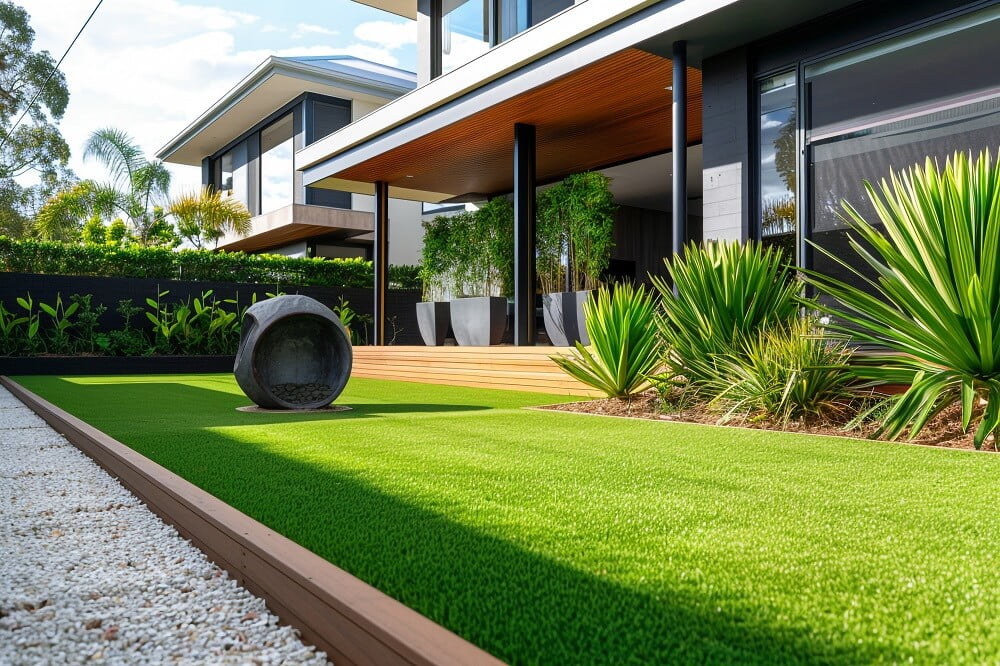
Lawn edging plays a key role in the garden, both from a functional and aesthetic point of view. First of all, they help to demarcate the boundaries between the lawn and flower beds, paths or other garden features, preventing grass from growing into areas where it is not desired. Thanks to edging, the overall appearance of the garden becomes neater and tidier, which contributes to its aesthetics. Edging also makes it easier to look after the lawn and other plants as it separates different zones, making mowing and watering easier. In addition, edging can have a protective function — it protects the beds from mechanical damage caused, for example, by a lawnmower. The right edging materials, such as stone, wood or metal, can also provide an attractive decorative element to emphasise the style of the garden.
The most popular edging in concrete, plastic, metal and wood. Concrete garden edging are durable and weatherproof, ideal for classic gardens. The disadvantages can be their weight and difficulty of installation. Metal edging is modern and durable, but can heat up and rust over time. Wooden garden edging give a natural look and blend well with different types of gardens, but require regular maintenance and are less durable, especially in humid climates. Plastic garden edging are light, flexible and easy to assemble. They allow for easy shaping and adaptation to different shapes. They are the most popular choice to suit gardens of any style.
The first step is to mark the line along which you will install the edging. You can use string or special garden markers to draw a straight line. Remember to measure carefully and verify the shape, especially if you are planning curved lines. Before you start lay lawn edgingThe ground must be prepared accordingly. First, remove any weeds and vegetation to ensure a stable foundation. You can do this by digging up the soil about 15 cm deep along the planned lawn line. Then, level the area by removing stones, branches and other obstacles. Make sure the ground is level and stable to avoid the edging settling later. Now that the area is ready, you can move on to installing your chosen material, according to the manufacturer’s recommendations. Whichever edging you choose, a well-prepared area will ensure the durability and aesthetic appearance of your garden.
Many novice gardeners ask the question, how to lay a lawn edging? It is worth knowing that this is a process that requires precision and patience, but the end result will certainly reward the effort put in. We start by marking out the line along which the edging will be placed, using string or spray paint to get a straight and even line. Next, we prepare the edging itself — whether stone, wood, metal or plastic — making sure it is properly cut to the required lengths. The next step is to place the edging in a trench of sufficient depth so that its top edge is level with the surface of the lawn or slightly above. It is a good idea to use a rubber mallet to gently hammer the edging in to avoid damaging it. Once the edging is in place, we fill the space around it with soil or sand, tamping carefully to ensure stability and prevent shifting. Finally, we check the level, using a spirit level, and correct any unevenness. Now that you know, how to lay lawn edgingYou can be sure of their durability and aesthetic appearance.
One of the most common mistakes in laying lawn edging is improper site preparation. Ignoring steps such as removing weeds or levelling the ground can lead to instability and rapid destruction of the edging.
Other common errors include:
To avoid these problems, it is a good idea to carefully follow all the steps described in the previous paragraph. By following these tips, it is possible to avoid common mistakes when laying lawn edging. Remember that careful preparation and diligent installation is the key to a lasting and aesthetically pleasing result.